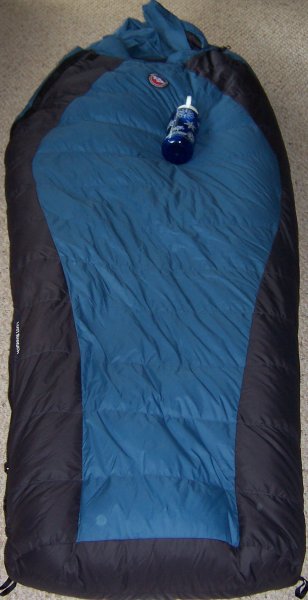 Big Agnes Lost Ranger
Big Agnes Lost Ranger
Big Agnes' Classic Series rectangular
sleeping bag
Andrew Buskov
Initial
Report - April 5, 2007
Field Report - June 18, 2007
Long Term Report - August 20, 2007
Tester
Biographical Information
| Name: |
Andrew Buskov |
| Age: |
32 |
| Gender: |
Male |
| Height: |
5 ft 9 in (1.75 m) |
| Weight: |
216 lbs (99 kg) |
| Shoulder Girth: |
48 in (122 cm) |
| Hip Girth: |
44 in (112 cm) |
| Email: |
Rescue(at)Corridor9(dot)net |
| City, State Zip |
Madisonville, Kentucky USA |
Backpacking Background:
I started backpacking and quickly
became hooked on the
outdoors, hiking various environments from the green mountains of the
Appalachians to the barren desert of Arizona. I enjoy the solitude of
deep
backcountry, and prefer colder weather but global warming is making
that
tougher all the time. I’m usually a moderate weight
hiker, but as an
Emergency Medical Technician I’m trained to be prepared, so
my pack usually
weighs between 30 to 40 lbs (13 and 18 kg) while soloing, to 60 lbs (27
kg)
when leading. Additional information about the author can be found at http://www.corridor9.net.
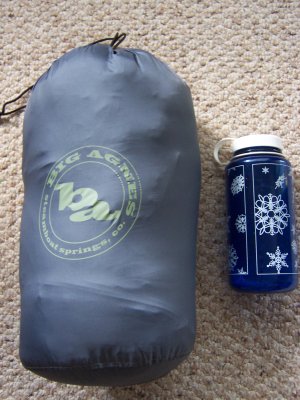 Product Information: Product Information:
| Item: |
Big Agnes Lost Ranger |
| Manufacturer: |
Big Agnes |
| Website |
http://www.bigagnes.com |
| Year of Manufacture: |
2007 |
| MSRP: |
$199.00 |
| Actual Weight: |
Regular / 2 lb 9 oz (1.16 kg)
|
| Listed Weight: |
Regular / 2 lb 10 oz (1.19 kg) |
| Stuffsack Size: |
8 x 17.5 in ( 20 x 44 cm) |
| Compressed Size: |
8 x 7.5 in ( 20 x 19 cm) |
| Shoulder Girth: |
70 in (178 cm) |
| Hip Girth: |
66 in (168 cm) |
| Pad Length: |
20 x 72 in (51 x 183 cm) |
| Fill Weight: |
14 oz (.40 kg) |
| Color: |
Blue / Black |
Product Overview:
{Paraphrased
from Website}
The Big Agnes Lost Ranger is part of the classic
series down sleeping bag line; the most popular bag style that
Big Agnes sells. Their semi-rectangular design makes them great for car
camping while still being light weight and offering a great deal of
compression for backpackers. Like every other Big Agnes sleeping bag,
the Lost Ranger has no insulation on the bottom (backside) of the
sleeping bag. The design requires a pad to be used to provide
insulation from the
ground. This particular bag is designed to be used with a 20 in (51 cm)
wide rectangular pad. Because the pad is required to provide adequate
insulation, Big
Agnes designed their bags to incorporate the pad into the sleep system.
Instead of the sleeping bag lying on top of the pad, there is an
integrated pad sleeve on the bottom of the bag. Some of the benefits
that come with such a design are: weight savings, reduced packed size,
increased girth and comfort, and the ability to roll or twist without
rolling off the pad. In addition, because the bag is a rectangular
design, there is more room around the shoulders and feet making it
easier for those of us who roll often at night to get a more restful
sleep without feeling like we're getting ensnared in the material.
 {From Packaging and Website} {From Packaging and Website}
Some of the additional features that are found in the Lost Ranger are:
- No-draft yoke seals around neck to keep cold air from
sneaking in.
- Built in pillow pocket holds a fleece or Big Agnes Pillow.
- No-draft wedge insulates the connection between the bag
and pad.
- No-draft zipper tube insulates along the length of the
zipper.
- Interior fabric loops for sleeping bag liners.
- 70" YKK #8 zipper. Mate together any of our left and right
zip bags with a 70" zipper.
Initial Impression:
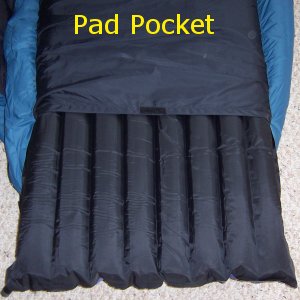 This item arrived in good condition, complete,
and very
neatly packaged
within a plastic bag. Included in the packaging was a stuffsack, shown
above, a cotton storage sack, and Big Agnes Catalog. Also included in
the package was a Big Agnes Dual Core inflatable air mattress that will
be used during the test in conjunction with the Lost Ranger. This item arrived in good condition, complete,
and very
neatly packaged
within a plastic bag. Included in the packaging was a stuffsack, shown
above, a cotton storage sack, and Big Agnes Catalog. Also included in
the package was a Big Agnes Dual Core inflatable air mattress that will
be used during the test in conjunction with the Lost Ranger.
As usual, one of the first things I did when opening the package was to
get initial weights and measurements before subjecting the Lost Ranger
to any use. After getting all pertinent information I couldn't help but
unroll everything, inflate the Dual Core pad, mate the two together and
hop in. One of the first things I noticed was how breathable this bag
seemed to be. I must admit, I was getting worried that I wouldn't have
an adequate amount of cold weather to test a 15 F (-9 C) sleeping bag
without sweating to death. However, I found that while I was
warm and cozy, I wasn't exceptionally hot even after laying in the Lost
Ranger for approximately 30 minutes in my 72 F (22 C) living room.
While I'm sure that I'll need to find colder weather than what we've
been experiencing lately, 80's F (27 C), I'm no longer worried about
soaking the bag with sweat. This does bring another question to mind
that I hadn't thought of before though; being as how there isn't any
insulation on the bottom side of the bag, will I be able to regulate my
body temperature if I get too hot simply by unzipping the bag and
allowing the heat to vent?
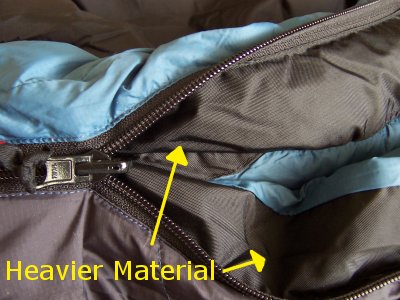 I don't normally think about
the setup time for a sleeping bag, but with the Big Agnes system it
isn't quite as easy as unrolling a bag and hopping in. This is
especially true in colder weather as the bottom of the bag has no
insulation. That being said, setup time for the bag was almost
nonexistent as the majority of the setup time was spent inflating the
Dual Core air pad. After the pad was inflated it was simply a matter of
sliding the sleeping bag over the pad. At no point in time did the
material snag or catch while sliding the air pad inside its designated
pocket. I haven't had the opportunity to test my Therm-O-Rest with the Lost Ranger, but I will definitely try to get some
additional information regarding different pad types and sizes. The
Lost Ranger is sewn in such a way that the valve from an inflatable pad
sticks out of the pocket. This allows quick and easy access to the
valve in case adjustments are needed for comfort throughout the night. I don't normally think about
the setup time for a sleeping bag, but with the Big Agnes system it
isn't quite as easy as unrolling a bag and hopping in. This is
especially true in colder weather as the bottom of the bag has no
insulation. That being said, setup time for the bag was almost
nonexistent as the majority of the setup time was spent inflating the
Dual Core air pad. After the pad was inflated it was simply a matter of
sliding the sleeping bag over the pad. At no point in time did the
material snag or catch while sliding the air pad inside its designated
pocket. I haven't had the opportunity to test my Therm-O-Rest with the Lost Ranger, but I will definitely try to get some
additional information regarding different pad types and sizes. The
Lost Ranger is sewn in such a way that the valve from an inflatable pad
sticks out of the pocket. This allows quick and easy access to the
valve in case adjustments are needed for comfort throughout the night.
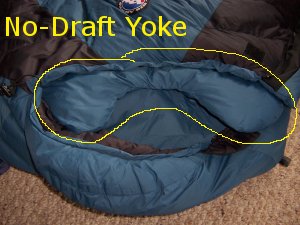 The
zipper worked really well and didn't seem to catch as much as some
other bags I've tried over the years. While any zipper has the
possibility of catching on material, especially a draft tube, the Lost
Ranger has a heavier fabric sewn right next to the zipper. This helps
give some rigidity to the bag around the zipper and help prevent the
zipper from catching on the fabric. I've found that this works
especially well when zipping from the outside of the bag, but it has
helped me a few times when I was inside the bag trying to zip it fully
without catching any material. I'm sure I'll be able to comment on ease
of use with the zipper in my Field Report. The
zipper worked really well and didn't seem to catch as much as some
other bags I've tried over the years. While any zipper has the
possibility of catching on material, especially a draft tube, the Lost
Ranger has a heavier fabric sewn right next to the zipper. This helps
give some rigidity to the bag around the zipper and help prevent the
zipper from catching on the fabric. I've found that this works
especially well when zipping from the outside of the bag, but it has
helped me a few times when I was inside the bag trying to zip it fully
without catching any material. I'm sure I'll be able to comment on ease
of use with the zipper in my Field Report.
So far I only have good things to report on in the way of fit. The wide
rectangle shape offers me extra shoulder room while the foot box is
large enough that my feet don't feel confined. Although I was only in
the sleeping bag for roughly a half hour, I was able to move around
freely and didn't at all feel constricted. I was even able to roll on
my sides and raise my knees up without too much trouble. I did find
that the yoke fit nice and snug around my neck; aka: tight for me.
However, as this is the first sleeping bag I have owned with a no-draft
yoke sewn inside, I'm sure this will take some getting used to. I'll
give a bit more information on this in future additions to the report.
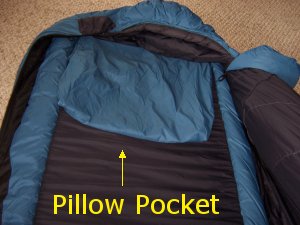 Another
feature of the Lost Ranger is the integrated pillow pocket inside the
head area of the bag. This to me seems quite ingenious as I'm always
losing my "pillow" throughout the night due to tossing and turning.
While the pocket was initially designed to hold one of Big Agnes'
pillows, it is my intention to test this using my regular fleece jacket
or other clothing. I'm hoping that this holds my clothing in one place
and prevents it from ending up where it usually does after a night of
restless sleep; at my feet. Another
feature of the Lost Ranger is the integrated pillow pocket inside the
head area of the bag. This to me seems quite ingenious as I'm always
losing my "pillow" throughout the night due to tossing and turning.
While the pocket was initially designed to hold one of Big Agnes'
pillows, it is my intention to test this using my regular fleece jacket
or other clothing. I'm hoping that this holds my clothing in one place
and prevents it from ending up where it usually does after a night of
restless sleep; at my feet.
One of the things that I wasn't happy with so far was the stitching on
the inside of the bag. After laying there for 15 minutes I could feel
the stitches on the inside of the bag scratching my arms and legs. It
feels like Big Agnes used a heavy thread to stitch the baffle areas
together. This heavy thread causes some discomfort when exposed to
bare skin. While I'm not looking forward to getting scratched all night
long, I'm definitely looking forward to testing this in the field. I'll
definitely have a bit more information during the next phase of the
report.
 Another
thing that I found a bit annoying was the amount of "free radical
feathers" that were on, in, and around the sleeping bag when I unpacked
it. While I
understand that most down equipment is going to come with some loose
down feathers, the fact that there was around 30-40 loose feathers
floating around my living room was a bit disheartening. I ended up
having to vacuum the bag to remove most of the feathers prior to use.
After removing all the loose feathers, and inspecting the bag carefully, I can't find any down leaking
from the insides of the sleeping bag. Another
thing that I found a bit annoying was the amount of "free radical
feathers" that were on, in, and around the sleeping bag when I unpacked
it. While I
understand that most down equipment is going to come with some loose
down feathers, the fact that there was around 30-40 loose feathers
floating around my living room was a bit disheartening. I ended up
having to vacuum the bag to remove most of the feathers prior to use.
After removing all the loose feathers, and inspecting the bag carefully, I can't find any down leaking
from the insides of the sleeping bag.
I would like to thank Big Agnes and Backpackgeartest.org for allowing
me to test this sleeping bag.
Field Report - June 18, 2007
Field Locations:I've
had the opportunity to test this bag a total of four nights so far. Two
nights were in the Pennyrile State Forrest about 45 minutes south of
here. The area has an elevation between 400 -700 ft (122 - 213 m). The
second place I used the sleeping bag was in the South Cumberland
Recreational area in southern Tennessee. Elevation change is a bit more
pronounced here since it's basically a big gouge in the earth. The
highest elevation is around 1800 ft (549 m) while the bottom of the
canyon tops out at roughly 980 ft (299 m). While there was a bit of
precipitation during the hike, it was merely a trace amount and the
night was dry. I was able to use both a tent, and bunks in a
cabin.
Performance:
I am exceptionally pleased with
the Big Agnes Lost Ranger! During initial tests around the house, I
thought that the bag was going to be too warm for use as a summer bag,
but I've since found out that because there is no insulation on the
back, I am able to easily regulate my body temperature by opening the
side of the bag to vent or simply removing the top and sleeping without
covers. This is great for those nights when the temperature drops and
you need that extra warmth but don't want to sweat while falling asleep.
The
bag fits me very well, and I'm glad I didn't get the long version.
While I am slightly cramped when fully zipped in my hood, I feel warmer
and actually prefer that as opposed to excess material floating or hanging
around my head or feet as I sleep. The bag is big enough that I am able
to take a "special bottle" in for those cold nights when I don't want
to leave the warmth of my bag to find the closest tree, but I have
found that when I do need to leave the bag it will retain some of the
heat so I don't have to rewarm it when I get back. I'm also able to
have both my CamelBak and Nalgene bottles in and still have room to
move around.
The hood, draft collar, and footbox area all feel
nice and tight when fully zipped. I don't exactly like the amount of
feathers in the draft collar as it feels a bit tight on my neck at
times, but it does do its job at retaining the heat. The pillow pocket
area is great for stuffing a sweater or some extra shirts for a
makeshift pillow. This is great for me, especially since I don't like a
big fluffy pillow anyway. I was a bit upset that the strings that cinch
up the hood are the same. This makes it hard to tell whether I'm
cinching the bottom or top of the hood area without trying them out. It
would have been nice to have a ribbon for the bottom and a round cord
for the top, but the cords that are provided do a good job at cinching
up the bag and are easy to use.
This bag lofts up great! Even
when I left it compressed for 2-3 days before finally heading out, upon
reaching camp it lofted up quickly and without clumping the down. At no
time did I feel that the down inside the bag was migrating to new areas
or clumping. Even after the bag had become damp with perspiration and
condensation the down was easy to manage. The bag dried real quick too
after hanging from a tree the next morning. The next night, I could
hardly tell that the bag was wet the night before. While the bag
doesn't seem to breath all that well, it doesn't pose a problem since
it is easy enough to vent during temperate weather. I've also not had
any more problems with down feathers bleeding through the fabric.
I've
found that the warmest I am comfortable using this bag is about 68 F
(20 C). After that I tend to sweat more than I can comfortably
evaporate. Of course, humidity, wind speed, and tent dynamics all play
a part in comfort while using the Lost Ranger, but this is the figure
I've come up with so far. In addition to the factors above, I've found
that the pad style plays a big part in how warm or cold I get during
the night. When I used the Big Agnes Dual Core pad, I stayed nice and
cozy during cold nights, but during warm nights it was much more
comfortable to use myself inflating short pad. However, this short pad
tended to roam around a bit more during the night when I rolled over
while the Dual Core stayed in the same place all night.
Long Term Report - August 20, 2007
Field Locations:Unfortunately
with this extreme heat wave we've been having the last month, anything
but day trips were out of the question. I was only able to use this sleeping bag
on one night during the Long Term phase. The location was the Pennyrile
State Forest and the
elevation for the area is between 400 -700 ft (122 - 213 m) with slow
rolling hills and steep cliffs in some areas.
The temperature was roughly 85 F (29 C). There was very little
precipitation and the humidity was high.
Performance:The
first time I had ever been exposed to a Big Agnes designed sleeping bag
was shortly after opening the package that the Lost Ranger came in. I
had only limited knowledge about the design and construction, the fact
that the back had no insulation, and that the sleeping bags were
primarily rectangular as opposed to the classic mummy style cold
weather bags. The first time I tried it out I was skeptical about the
ability to keep my back warm with only a thin sheet of fabric. However,
after coupling the bag with the Dual Core air mattress I quickly
realized exactly how well this proved at insulating me from the cold
ground.
The
bag is extremely well constructed, and designed. The
heavy duty material along the zipper prevented me from ever snagging
this entire test period. Being as how I sleep on my stomach a lot,
leaving only my left arm to pull the zipper with, I often snag simply
because the awkward way my arm articulates while in that position. In
addition, the heavy duty draft collar kept in a lot of warmth during
the colder months. I also appreciated the ease of the drawstrings. I
would have liked to see some way of distinguishing the
drawstrings in the dark. I often found myself pulling the wrong
drawstring and closing the hood down over my eyes as opposed to
cinching up the neck area. I've seen other bags that had a flat, or
ribbon style, drawstring around for the neck area and a round, or
more of a rope style, drawstring for the head section.
When the Big Agnes Lost Ranger
arrived at the beginning of April, I was a little hesitant about
testing a 15 F (-9 C), cold weather bag, especially seeing as how the
next few months were going to warm up considerably. With temperatures
here peaking over 105 F (41 C), temperatures were scorching, humidity
was high, and testing was hot. That being said, I wasn't as
uncomfortable with this sleeping bag as I was my synthetic 15 F
(-9 C) sleeping bag. For some reason, while the down provided a
wonderful amount of heat retention, it wasn't a miserable experience. I
would have to say that as it stands now, using the Dual Core air
mattress, I probably won't use this sleeping bag over 55 or 60 F (13 or
16 C). However, with a different non-insulated air mattress, this may
be a bit more feasible.
The thing that really sticks out in my
head though about this bag is it's compressibility. It is one of the
factors that will keep me coming back to this bag every winter. I can
compress this bag down to just about any leftover space I have in my
pack and it is still fluffy and full when I unpack it. I no longer need
a space the size of two basketballs for my sleeping bag. That makes all
the difference when packing for a long trip. This bag was a joy to
test, and I've been very pleased with all aspects of the sleeping bag.
I'll definitely be using this bag for many years to come.
I'd like to thank BackpackGearTest.org and Big Agnes for the opportunity to test the Lost Ranger.
Read more reviews of Big Agnes gear
Read more gear reviews by Andrew Buskov
|






 {From Packaging and Website}
{From Packaging and Website} This item arrived in good condition, complete,
and very
neatly packaged
within a plastic bag. Included in the packaging was a stuffsack, shown
above, a cotton storage sack, and Big Agnes Catalog. Also included in
the package was a Big Agnes Dual Core inflatable air mattress that will
be used during the test in conjunction with the Lost Ranger.
This item arrived in good condition, complete,
and very
neatly packaged
within a plastic bag. Included in the packaging was a stuffsack, shown
above, a cotton storage sack, and Big Agnes Catalog. Also included in
the package was a Big Agnes Dual Core inflatable air mattress that will
be used during the test in conjunction with the Lost Ranger. I don't normally think about
the setup time for a sleeping bag, but with the Big Agnes system it
isn't quite as easy as unrolling a bag and hopping in. This is
especially true in colder weather as the bottom of the bag has no
insulation. That being said, setup time for the bag was almost
nonexistent as the majority of the setup time was spent inflating the
Dual Core air pad. After the pad was inflated it was simply a matter of
sliding the sleeping bag over the pad. At no point in time did the
material snag or catch while sliding the air pad inside its designated
pocket. I haven't had the opportunity to test my Therm-O-Rest with the Lost Ranger, but I will definitely try to get some
additional information regarding different pad types and sizes. The
Lost Ranger is sewn in such a way that the valve from an inflatable pad
sticks out of the pocket. This allows quick and easy access to the
valve in case adjustments are needed for comfort throughout the night.
I don't normally think about
the setup time for a sleeping bag, but with the Big Agnes system it
isn't quite as easy as unrolling a bag and hopping in. This is
especially true in colder weather as the bottom of the bag has no
insulation. That being said, setup time for the bag was almost
nonexistent as the majority of the setup time was spent inflating the
Dual Core air pad. After the pad was inflated it was simply a matter of
sliding the sleeping bag over the pad. At no point in time did the
material snag or catch while sliding the air pad inside its designated
pocket. I haven't had the opportunity to test my Therm-O-Rest with the Lost Ranger, but I will definitely try to get some
additional information regarding different pad types and sizes. The
Lost Ranger is sewn in such a way that the valve from an inflatable pad
sticks out of the pocket. This allows quick and easy access to the
valve in case adjustments are needed for comfort throughout the night. The
zipper worked really well and didn't seem to catch as much as some
other bags I've tried over the years. While any zipper has the
possibility of catching on material, especially a draft tube, the Lost
Ranger has a heavier fabric sewn right next to the zipper. This helps
give some rigidity to the bag around the zipper and help prevent the
zipper from catching on the fabric. I've found that this works
especially well when zipping from the outside of the bag, but it has
helped me a few times when I was inside the bag trying to zip it fully
without catching any material. I'm sure I'll be able to comment on ease
of use with the zipper in my Field Report.
The
zipper worked really well and didn't seem to catch as much as some
other bags I've tried over the years. While any zipper has the
possibility of catching on material, especially a draft tube, the Lost
Ranger has a heavier fabric sewn right next to the zipper. This helps
give some rigidity to the bag around the zipper and help prevent the
zipper from catching on the fabric. I've found that this works
especially well when zipping from the outside of the bag, but it has
helped me a few times when I was inside the bag trying to zip it fully
without catching any material. I'm sure I'll be able to comment on ease
of use with the zipper in my Field Report. Another
feature of the Lost Ranger is the integrated pillow pocket inside the
head area of the bag. This to me seems quite ingenious as I'm always
losing my "pillow" throughout the night due to tossing and turning.
While the pocket was initially designed to hold one of Big Agnes'
pillows, it is my intention to test this using my regular fleece jacket
or other clothing. I'm hoping that this holds my clothing in one place
and prevents it from ending up where it usually does after a night of
restless sleep; at my feet.
Another
feature of the Lost Ranger is the integrated pillow pocket inside the
head area of the bag. This to me seems quite ingenious as I'm always
losing my "pillow" throughout the night due to tossing and turning.
While the pocket was initially designed to hold one of Big Agnes'
pillows, it is my intention to test this using my regular fleece jacket
or other clothing. I'm hoping that this holds my clothing in one place
and prevents it from ending up where it usually does after a night of
restless sleep; at my feet.  Another
thing that I found a bit annoying was the amount of "free radical
feathers" that were on, in, and around the sleeping bag when I unpacked
it. While I
understand that most down equipment is going to come with some loose
down feathers, the fact that there was around 30-40 loose feathers
floating around my living room was a bit disheartening. I ended up
having to vacuum the bag to remove most of the feathers prior to use.
After removing all the loose feathers, and inspecting the bag carefully, I can't find any down leaking
from the insides of the sleeping bag.
Another
thing that I found a bit annoying was the amount of "free radical
feathers" that were on, in, and around the sleeping bag when I unpacked
it. While I
understand that most down equipment is going to come with some loose
down feathers, the fact that there was around 30-40 loose feathers
floating around my living room was a bit disheartening. I ended up
having to vacuum the bag to remove most of the feathers prior to use.
After removing all the loose feathers, and inspecting the bag carefully, I can't find any down leaking
from the insides of the sleeping bag.